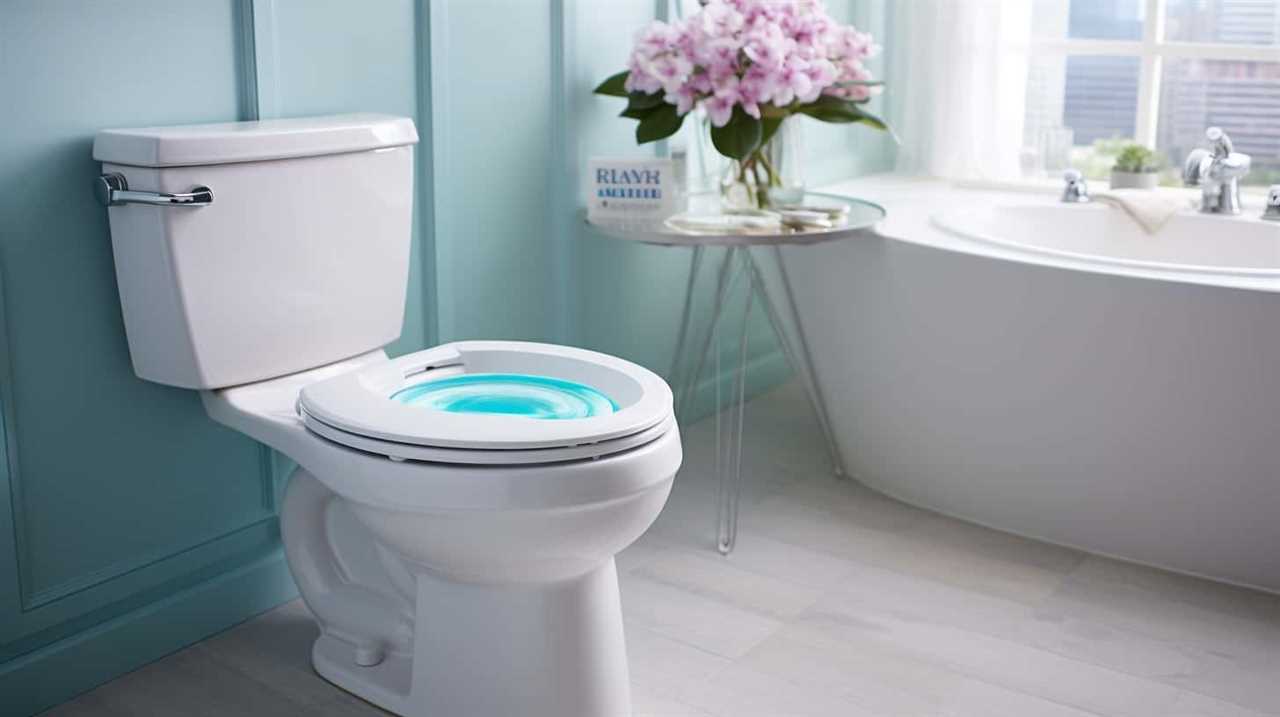Are you frustrated with a toilet that won’t fill with water? Don’t worry, we have the solution you’ve been looking for!
In this article, we’ll guide you through the steps to troubleshoot and fix this frustrating issue. From checking the water supply valve to examining the float mechanism, we’ll cover it all.
So, let’s roll up our sleeves and get ready to tackle this problem head-on!
Key Takeaways
- Check the water supply valve to ensure it is fully open.
- Inspect the fill valve for any leaks, cracks, or damage.
- Clean or replace the clogged inlet valve to ensure proper water flow.
- Troubleshoot the toilet tank flapper by checking its tension, inspecting and replacing the flapper chain if necessary, and cleaning the flapper and flush valve for a tight seal.
Check the Water Supply Valve
After diagnosing a toilet that won’t fill with water, we recommend checking the water supply valve. The water supply valve is responsible for controlling the flow of water into the toilet tank. Over time, debris and sediment can accumulate in the valve, leading to decreased water pressure and ultimately preventing the tank from filling properly.

To address this issue, it’s important to perform regular plumbing maintenance by checking and cleaning the water supply valve. Start by shutting off the water supply to the toilet and then carefully inspect the valve for any signs of blockage or damage. Clean the valve thoroughly, removing any buildup that may be hindering water flow.
Inspect the Fill Valve
To address the issue of a toilet not filling with water, we need to inspect the fill valve. The fill valve is responsible for controlling the flow of water into the toilet tank. If it is not functioning properly, it can prevent the tank from filling up. There are two possible solutions to this problem: adjusting the fill valve or replacing it altogether.
To determine the best course of action, we can refer to the following table:
| Issue | Solution |
|---|---|
| Fill valve is stuck | Adjust the fill valve |
| Fill valve is worn out | Replace the fill valve |
If the fill valve is stuck, it may just need a simple adjustment. This can be done by turning the adjustment screw on the valve. If the fill valve is worn out or damaged, it will need to be replaced with a new one. This can be a more involved process, but it is necessary to ensure the proper functioning of the toilet. By inspecting the fill valve and taking the appropriate action, we can resolve the issue of a toilet not filling with water.

Examine the Float Mechanism
Now let’s examine the float mechanism to further investigate why the toilet isn’t filling with water.
The float mechanism is responsible for regulating the water level in the toilet tank. Here are some possible reasons why the float mechanism may be causing the issue:
- The float level may be set too low, preventing the mechanism from activating the fill valve properly. To fix this, you can adjust the float level by turning the adjustment screw clockwise to raise it.
- The float may be damaged or malfunctioning. In this case, it’s recommended to replace the float mechanism entirely.
- The float may be stuck in the down position, preventing it from rising and activating the fill valve. Try gently pushing the float up to see if it moves freely.
- The float arm may be bent or misaligned, causing it to interfere with the proper functioning of the float mechanism. Check the float arm and adjust or straighten it if necessary.
- There may be a blockage or debris in the float mechanism, hindering its movement. Clean the float mechanism thoroughly to remove any obstructions.
Clean or Replace the Clogged Inlet Valve
Let’s clean or replace the clogged inlet valve to address the issue of the toilet not filling with water. The inlet valve is responsible for allowing water to enter the toilet tank. If it becomes clogged, water flow will be restricted or completely blocked, resulting in the toilet not filling with water. Cleaning or replacing the clogged inlet valve can resolve this problem.
To clean the clogged inlet valve, follow these steps:

- Shut off the water supply to the toilet.
- Remove the inlet valve cap.
- Use a small brush or toothbrush to scrub away any debris or mineral deposits that may be clogging the valve.
- Rinse the valve thoroughly to remove any loosened debris.
- Reassemble the valve and turn on the water supply.
If cleaning the valve doesn’t solve the issue, it may be necessary to replace it. Refer to the manufacturer’s instructions or consult a professional plumber for guidance on replacing the clogged inlet valve.
To ensure proper water flow and avoid future clogs, it’s also important to regularly clean the toilet bowl and adjust the water level as needed.
Troubleshoot the Toilet Tank Flapper
First, we need to troubleshoot the toilet tank flapper. Here are some steps to help you identify and fix the issue:
- Check flapper tension: Ensure that the flapper is properly aligned and has enough tension to seal the flush valve. Adjust the tension if necessary by bending the flapper’s metal arm slightly.
- Inspect flapper chain: Examine the chain connecting the flapper to the flush handle. If it’s too loose or tangled, it may prevent the flapper from closing properly. Replace the chain if needed.
- Clean flapper and flush valve: Remove any debris or mineral buildup from the flapper and flush valve to ensure a tight seal.
- Replace worn-out flapper: If the flapper is cracked, warped, or worn out, it won’t create a proper seal. Replace it with a new one to restore functionality.
- Check water level: Ensure that the water level in the toilet tank is set correctly. If it’s too low, the flapper may not be able to seal the flush valve properly.
Frequently Asked Questions
How Do I Know if the Water Supply Valve Is the Cause of My Toilet Not Filling With Water?
To troubleshoot a toilet that won’t fill up, we need to check if the water supply valve is the cause. If the valve is faulty or closed, it can prevent water from entering the toilet tank.

What Are the Common Signs of a Faulty Fill Valve That May Be Preventing My Toilet From Filling With Water?
If your toilet will not fill with water, a faulty fill valve could be the culprit. Signs of a faulty fill valve include low water levels, slow filling, and water leaking from the valve.
How Can I Determine if the Float Mechanism Is Causing the Issue With My Toilet Not Filling?
To determine if the float mechanism is causing the issue with our toilet not filling, we must inspect it for any signs of malfunction. Additionally, we should check the water supply valve for any blockages or leaks.
What Are the Steps Involved in Cleaning or Replacing a Clogged Inlet Valve to Resolve the Problem of a Toilet Not Filling With Water?
To resolve a toilet not filling with water, we need to clean or replace a clogged inlet valve. By following these steps, we can ensure proper functioning and prevent further issues with the toilet.
Are There Any Troubleshooting Tips Specifically Related to the Toilet Tank Flapper That I Should Consider if My Toilet Is Not Filling With Water?
If your toilet is not filling with water, troubleshooting the toilet tank flapper is essential. We’ll discuss the steps for replacement and provide tips for troubleshooting the flapper to resolve the issue.

Conclusion
In conclusion, troubleshooting a toilet that won’t fill with water requires checking the water supply valve. This valve controls the flow of water into the toilet tank, so if it is closed or partially closed, it can prevent the tank from filling properly.
Another potential issue to consider is the fill valve. This valve is responsible for regulating the water level in the toilet tank. If it is damaged or malfunctioning, it may not allow water to enter the tank and fill it up.
The float mechanism is also worth examining. This mechanism is connected to the fill valve and helps regulate the water level in the tank. If it is stuck or misaligned, it can prevent the tank from filling properly.
Lastly, a clogged inlet valve can also prevent water from flowing into the toilet tank. In this case, cleaning or replacing the inlet valve may be necessary to restore proper water flow.

By addressing these issues – checking the water supply valve, inspecting the fill valve, examining the float mechanism, and cleaning or replacing the clogged inlet valve – you can ensure that your toilet functions properly.
Remember, a well-maintained toilet is the key to a smooth-flowing day. So don’t let your toilet be a drain on your time and energy – fix it and flush away your worries!









